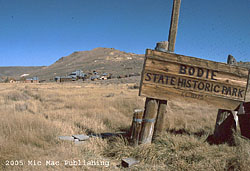 |
|
|||||||||||||||||||||||||||||||||||||
|
Follow Mark on Facebook for more stories |
|||||||||||||||||||||||||||||||||||||
|
Bodie, California — National Cold Spot Nevada is a region of climatic extremes, a land where surface temperatures have soared to a sizzling 125 degrees (June 1994 – Laughlin) or plunged to an Arctic-like 50 degrees below zero (January 1937 - San Jacinto). Few places in the world boast seasonal temperature swings of 175 degrees Fahrenheit, but Nevada is more unique than that. Cool mornings and warm afternoons are the norm in the valleys of the Silver State, where temperature inversions are a regular feature. Nevada's su
The same atmospheric and topographic features that contribute to intense early morning inversions in this part of the country also generate some of the coldest summertime temperatures in the "lower 48." According to data compiled by Dr. David Hickcox, a professor of geography and director of environmental studies at Ohio Wesleyan University, nearby Bodie, California ranked first last year in frequency of recording the national low temperature. Bodie registered the nation's lowest daily temperature 71 times in 1999. The primary factor that causes these temperature swings is the extremely dry air of the Great Basin, as well as cloudless skies and cold air draining from surrounding mountain slopes. In addition, the atmosphere cools at an average rate of 3.2 degrees Fahrenheit for every 1,000 feet gained in elevation, Bodie's weather station located at 8,368 feet above sea level virtually guarantees cooler summer readings. Prof. Hickcox, who has published his annual results in Weatherwise magazine for 16 years, uses a criteria that diminishes any single location's dominance and reduces the number of times a site will be a daily cold spot. Hickcox accepts temperature readings from small hamlets with populations of about 100 people and will also consider remote automated recording stations as well as locations such as Bodie, an abandoned mining town-turned-state park. In contrast to Hickcox's methodology, the National Weather Service will only consider towns with a minimum of 2,500 inhabitants in their daily survey of the nation's hottest and coldest temperatures. Both criteria exclude Alaska and Hawaii. Almost all of Bodie's national lows in 1999 occurred from June through early October, when high-elevation weather stations in California often record the nation's chilliest morning temperatures. In fact, in 1999, California stations recorded the most national low's with 80 total occurrences. Testament to our incredibly diverse regional geography (weather and climate don't respect state borders), California recorded both the national high and national low on 56 days during June, July, August, September and October. Death Valley, only 165 miles from cold spot Bodie, recorded the nation's highest temperature 86 times. |
|||||||||||||||
|
|||||||||||||||
|
|||||||||||||||
|
Just for the record, out of the last 16 years, Truckee, California has made the top five ranking 11 times. And three of those years, 1991, 1993 and 1994, Truckee claimed the dubious honor of coldest spot in the nation, excluding Alaska. (Special thanks to Prof. David Hickcox and Nevada State Climatologist John James for their generous assistance with this article.) Weather historian Mark McLaughlin's books Sierra Stories: True Tales of Tahoe, Volumes 1 & 2 are available at many book stores or through Mic Mac Media's website. |
|

 mmertime weather tends toward dry air and cloudless
conditions, which encourages accumulated daytime heat to escape rapidly back into the atmosphere after sunset, a dynamic known as radiational cooling. Cooler air drains down from surrounding
mountain slopes to pool in valley bottoms, forming intense shallow inversions. In the Spring, Summer and Fall, daytime heating rapidly warms the cold
air in the valleys so that chilly mornings are quickly replaced by warm to hot afternoons.
mmertime weather tends toward dry air and cloudless
conditions, which encourages accumulated daytime heat to escape rapidly back into the atmosphere after sunset, a dynamic known as radiational cooling. Cooler air drains down from surrounding
mountain slopes to pool in valley bottoms, forming intense shallow inversions. In the Spring, Summer and Fall, daytime heating rapidly warms the cold
air in the valleys so that chilly mornings are quickly replaced by warm to hot afternoons.